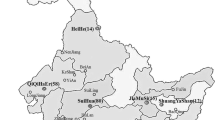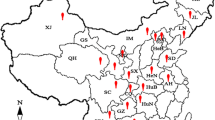Abstract
A collection of 241 isolates of Rhizoctonia solani obtained from potato plants grown in different areas in France was characterized for anastomosis grouping, symptomatology on tubers of different cultivars and sensitivity to three fungicides. Most isolates collected belonged to (anastomosis groups (AGs)) AG 3, but 2% and 4% of the isolates were AG 5 and AG 2-1. AG 3 and AG 2-1 isolates were mostly obtained from sclerotia on tubers, but all AG 5, some AG 3 and some AG 2-1 isolates were recovered from superficial tuber alterations, like deformations, corky or scabby lesions. Sclerotia were formed on tubers produced by healthy stem cuttings grown in soil artificially infested with AG 3, but not on tubers grown in soil infested with either AG 5 or AG 2-1. No variation in susceptibility to sclerotial formation was observed among five potato cultivars. In all cases, a large proportion of tubers showed superficial corky lesions, often associated with deformations. The proportion of tubers with lesions and deformations was highest in soil infested with AG 2-1 and significantly lower on cv. Samba in all treatments. All isolates were highly sensitive to flutolanil, iprodione and pencycuron, except the AG 5 isolates, moderately sensitive to pencycuron. These results show that, although AG 3 is the most common R. solani group on potato in France, AG 5 and AG 2-1 may be present. Isolates differed for pathogenicity. In vitro sensitivity to fungicides varied among AGs.
Similar content being viewed by others
References
Anderson NA (1982) The genetics and pathology of Rhizoctonia solani. Annual Review of Phytopathology 20: 329-347
Baker KF (1970) Types of Rhizoctonia diseases and their occurrence. In: Parmeter JR Jr (ed) Rhizoctonia solani, Biology and Pathology (pp 125-148) University of California Press, Berkeley
Balali GR, Neate SM, Scott ES, Whisson DL and Wicks TJ (1995) Anastomosis group and pathogenicity of isolates of Rhizoctonia solani from potato crops in South Australia. Plant Pathology 44: 1050-1057
Bandy BP, Zanzinger DH and Tavantzis SM (1984) Isolation of anastomosis group 5 of Rhizoctonia solani from potato field oils in Maine. Phytopathology 74: 1220-1224
Bouchek-Mechiche K, Pasco C, Andrivon D and Jouan B (2000) Differences in host range, pathogenicity to potato cultivars and response to soil temperature among Streptomyces species causing common and netted scab in France. Plant Pathology 49: 3-10
Bounou S, Jabaji-Hare SH, Hogue R and Charest PM (1999) Polymerase chain reaction-based assay for specific detection of Rhizoctonia solani AG-3 isolates. Mycological Research 103: 1-8
Campion C, Perraton B, Jouan B and Chatot C (1999) Diversity of Rhizoctonia solani pathogenic on potato in France and in the Mediterranean Basin. Abstracts of Conference Papers, Posters and Demonstration, 14th Triennial Conference of the EAPR, Sorrento 2-7 May 1999: 519-520
Carling DE and Leiner RH (1986) Isolation and characterization of Rhizoctonia solani and binucleate R. solani-like fungi from aerial stems and subterranean organs of potato plants. Phytopathology 76: 725-729
Carling DE and Leiner RH (1990) Effect of temperature on virulence of Rhizoctonia solani and other Rhizoctonia on potato. Phytopathology 80: 930-934
Carling DE, Leiner RH and Westphale PC (1989) Symptoms, signs and yield reduction associated with Rhizoctonia disease of potato induced by tuberborne inoculum of Rhizoctonia solani AG-3. American Potato Journal 66: 693-701
Carling DE, Kuninaga S and Brainard KA (2002) Hyphal anastomosis reactions, rDNA-internal transcribed spacer sequences, and virulence levels among subsets of Rhizoctonia solani anastomosis group-2 (AG-2) and AG-BI. Phytopathology 92: 43-50
Chand T and Logan C (1983) Cultural and pathogenic variation in potato isolates of Rhizoctonia solani in Northern Ireland. Transactions of the British Mycological Society 81: 585-589
Csinos AS and Stephenson MG (1999) Evaluation of fungicides and tobacco cultivar resistance to Rhizoctonia solani incited target spot, damping off and sore shin. Crop Protection 18: 373-377
Cubeta MA and Vilgalys R (1997) Population biology of the Rhizoctonia solani complex. Phytopathology 87: 480-484
Escande AR and Echandi E (1991) Protection of potato from Rhizoctonia canker with binucleate Rhizoctonia fungi. Plant Pathology 40: 197-202
Herr LJ (1979) Practical nuclear staining procedures for Rhizoctonia-like fungi. Phytopathology 69: 958-961
Jeger MJ, Hide GA, van den Boogert PHJF, Termorshuizen AJ and van Baarlen P (1996) Pathology and control of soil-borne fungal pathogens of potato. Potato Research 39: 437-469
Jouan B (1997) Les principales causes d'altérations superficielles des tubercules. La Pomme de Terre Française 499: 30-32
Kataria HR and Verma PR (1989) Variations in the sensitivity to fungicides among different anastomosis groups of Rhizoctonia solani. Canadian Journal of Plant Pathology 11: 192
Kataria HR, Hugelshofer U and Gisi U (1991) Sensitivity of Rhizoctonia species to different fungicides. Plant Pathology 40: 203-211
Leach LD and Garber RH (1970) Control of Rhizoctonia. In: Parmeter JR Jr (ed) Rhizoctonia solani, Biology and Pathology (pp 189-198) University of California Press, Berkeley
Martin SB, Lucas LT and Campbell CL (1984) Comparative sensitivity of Rhizoctonia solani and Rhizoctonia-like fungi to selected fungicides in vitro. Phytopathology 74: 778-781
Menzies JD (1970) Introduction: The first century of Rhizoctonia solani. In: Parmeter JR Jr (ed) Rhizoctonia solani, Biology and Pathology (pp 3-5) University of California Press, Berkeley
Ogoshi A (1987) Ecology and pathogenicity of anastomosis and intraspecific groups of Rhizoctonia solani Kühn. Annual Review of Phytopathology 25: 125-143
Parmeter JR Jr and Whitney HS (1970) Taxonomy and nomenclature of the imperfect state. In: Parmeter JR Jr (ed) Rhizoctonia solani, Biology and Pathology (pp 7-19) University of California Press, Berkeley
Parmeter JR Jr, Sherwood RT and Platt WD (1969) Anastomosis grouping among isolates of Thanatephorus cucumeris. Phytopathology 59: 1270-1278
Salazar O, Julian MC and Rubio V (2000) Primers based on specific rDNA-ITS sequences for PCR detection of Rhizoctonia solani, R. solani AG 2 subgroups and ecological types, and binucleate Rhizoctonia. Mycological Research 104: 281-285
Schneider JHM, Schilder MT and Dijst G (1997a) Characterization of Rhizoctonia solani AG 2 isolates causing bare patch in field grown tulips in the Netherlands. European Journal of Plant Pathology 103: 265-279
Schneider JHM, Salazar O, Rubio V and Keijer J (1997b) Identification of Rhizoctonia solani associated with field-grown tulips using ITS rDNA polymorphism and pectic zymograms. European Journal of Plant Pathology 103: 607-622
Scholte K (1989) Effects of soil-borne Rhizoctonia solani Kühn on yield and quality of ten potato cultivars. Potato Research 32: 367-376
Sokal RR and Rohlf FJ (1981) Biometry, the Principles and Practice of Statistics in Biological Research, 2nd edn. Freeman WH and Co., New York
Sumner DR (1987) Efficacy of pencycuron against isolates representing different anastomosis groups of Rhizoctonia solani and Rhizoctonia-like binucleate fungi. Plant Disease 71: 515-518
Turff R (2002) Fungus more complex than first thought. Potato Review: 4-6
Ueyama I, Araki Y, Kurogochi S, Yoneyama K and Yamaguchi I (1990) Mode of action of the phenylurea fungicide pencycuron in Rhizoctonia solani. Pesticide Science 30: 363-365
Vilgalys R and Gonzalez D (1990) Ribosomal DNA restriction fragment length polymorphisms in Rhizoctonia solani. Phytopathology, 80: 151-158
Virgen-Calleros G, Olalde-Portugal V and Carling DE (2000) Anastomosis groups of Rhizoctonia solani on potato in Central Mexico and potential for biological and chemical control. American Journal of Potato Research 77: 219-224
Weinhold AR, Bowman T and Hall DH (1978) Rhizoctonia disease of potato in California. American Potato Journal 55: 56-57
Williams DA (1976) Improved likelihood ratio tests for complete contingency tables. Biometrika 63: 33-37
Author information
Authors and Affiliations
Rights and permissions
About this article
Cite this article
Campion, C., Chatot, C., Perraton, B. et al. Anastomosis Groups, Pathogenicity and Sensitivity to Fungicides of Rhizoctonia solani Isolates Collected on Potato Crops in France. European Journal of Plant Pathology 109, 983–992 (2003). https://doi.org/10.1023/B:EJPP.0000003829.83671.8f
Issue Date:
DOI: https://doi.org/10.1023/B:EJPP.0000003829.83671.8f




